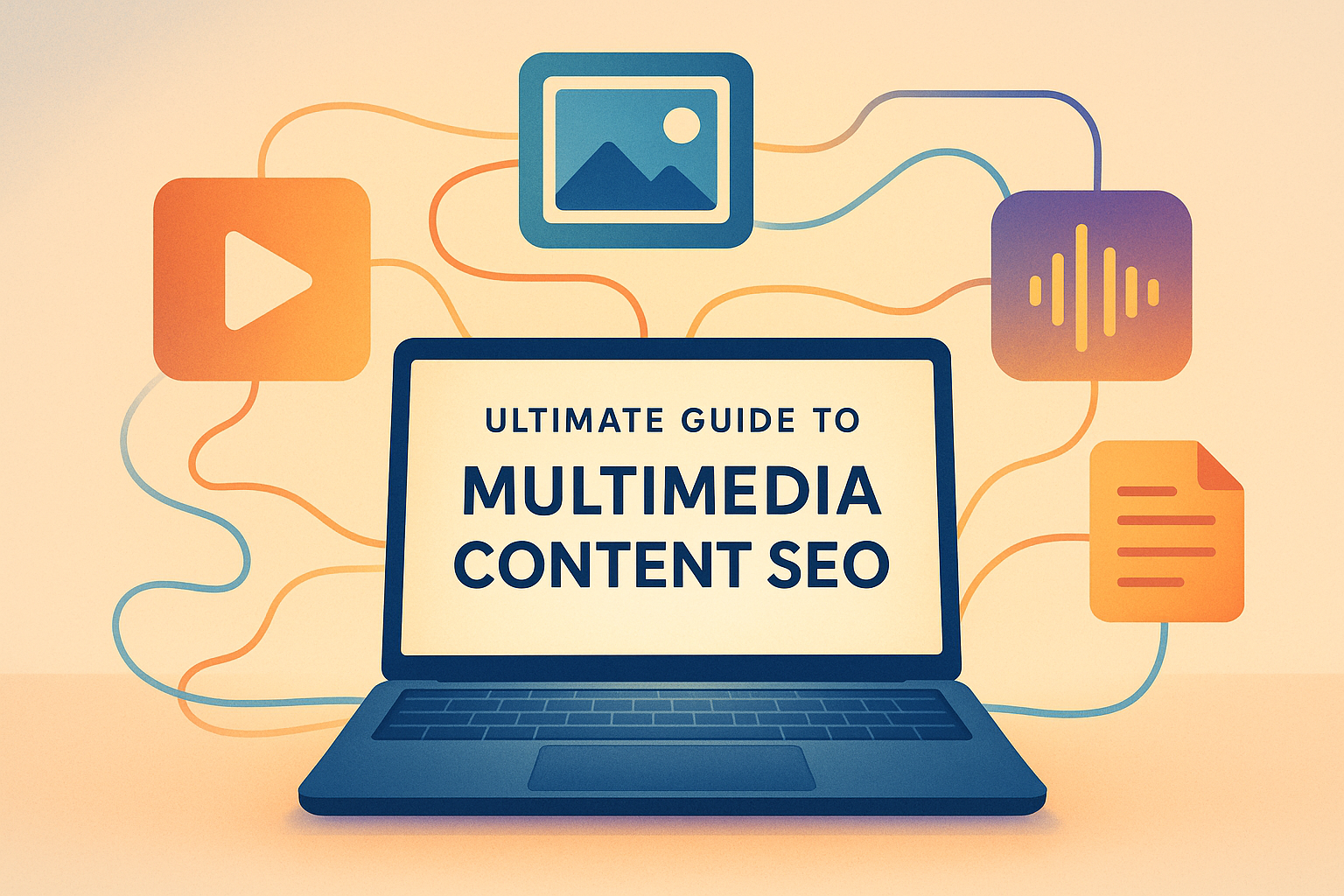Want your YouTube videos to rank higher and reach more viewers? The key lies in mastering YouTube SEO and leveraging YouTube Analytics. Here's what you need to know:
- YouTube SEO: Optimize video titles, descriptions, tags, thumbnails, and captions to align with YouTube's search algorithm, which prioritizes watch time, engagement, and click-through rates.
- YouTube Analytics: Track metrics like audience retention, traffic sources, and engagement (likes, comments, shares) to refine your strategy.
- 2025 Updates: YouTube now focuses on quality over quantity, with AI-driven content analysis, mobile optimization, semantic search, and Shorts integration playing a bigger role.
- Key Metrics: Watch time, retention graphs, click-through rates, and search terms are critical for improving your content's visibility.
Use data from YouTube Analytics to optimize your videos, refine your keywords, and create content that keeps viewers engaged. Start by checking weekly metrics, updating metadata monthly, and reviewing your strategy quarterly for better results.
YouTube Analytics - 9 Ways to Use YouTube Studio Analytics ...
Key YouTube Analytics Metrics for SEO
Improving your video SEO on YouTube starts with tracking a few key analytics metrics. These metrics reveal how your audience interacts with your content and guide adjustments to improve search visibility and rankings.
Watch Time Metrics
Average view duration measures how long viewers typically watch your video. Longer viewing times suggest your content is engaging, which can positively impact its search performance.
Viewer Retention Data
Check your retention graph to identify where viewers start dropping off. Use this information to tweak your video's pacing and structure to keep viewers watching longer.
Traffic Sources and Click Rates
Knowing how viewers find your content is crucial. By monitoring traffic sources like search results or recommendations and checking your click-through rate (CTR), you can see what’s working. This data helps you refine your video titles, thumbnails, and descriptions to attract more clicks.
Viewer Engagement Stats
Metrics like likes, comments, and shares show how your audience interacts with your video. These interactions signal to YouTube that your content resonates with viewers, which can help improve its visibility. Use this data to shape your future content strategy.
Using Analytics Data to Improve SEO
Turn YouTube Analytics insights into SEO success by focusing on key metrics and adjusting your approach.
Traffic Source Analysis
Pay close attention to these traffic sources:
- YouTube Search: Look at the search terms that bring viewers to your videos. Use this data to guide your content planning.
- Suggested Videos: Find out which videos your content is paired with. Use this to tap into related topics and audiences.
- External Sources: Track outside platforms driving traffic to your videos. Adjust your promotion strategies accordingly.
Prioritize traffic sources that bring in engaged viewers. For example, if your tutorial videos get more traction than entertainment ones, focus on creating more educational content. Use these trends to refine your keyword strategy.
Keyword Research Methods
Use these methods to improve your keyword game:
- Search Terms Report: Analyze the phrases viewers use to find your videos and spot recurring themes.
- Competitor Analysis: Examine metadata from top-performing videos in your niche to uncover useful keywords.
- Trending Topics: Stay updated on YouTube trends to find new keywords gaining traction.
Regularly update your video titles, descriptions, and tags with these high-performing keywords to stay relevant. Once your keywords are optimized, shift your focus to improving viewer retention.
Retention Data Applications
Retention data helps you keep viewers engaged and coming back. Here’s how to use it:
- Opening Hook: If viewers drop off early, improve your video introductions to grab attention right away.
- Content Pacing: Identify slow sections in your videos and tighten the editing to maintain interest.
- Peak Engagement: Pinpoint what parts of your videos keep viewers hooked and replicate those elements in future content.
Keeping your audience engaged not only improves watch time but also boosts your chances of being recommended to others.
sbb-itb-a84ebc4
YouTube Analytics SEO Action Plan
Use insights from YouTube Analytics to improve SEO and enhance video performance. Here's how to turn data into results.
Spotting Viewer Drop-off Points
Check retention graphs to identify where viewers lose interest - whether it's early on, mid-video, or during calls-to-action. Use this information to adjust your content. For example, make introductions more engaging, improve pacing, or simplify complex explanations by breaking them into shorter sections.
Refining Video Metadata
Analytics data can guide updates to your video metadata, helping attract more viewers and improve search rankings.
Optimizing Titles
- Add relevant search terms to titles, keeping them clear and engaging.
Improving Descriptions
- Place important keywords early in concise, well-written descriptions.
Updating Thumbnails
- Review click-through rates (CTR) and adjust thumbnails to make them more visually appealing.
Tracking SEO Progress
Monitor metrics like watch time, CTR, search traffic, and view duration to evaluate your SEO efforts. Regularly review and tweak your metadata to maintain performance.
YouTube SEO in Marketing Funnels
Use insights from your analytics to seamlessly integrate YouTube SEO into your broader marketing funnel.
Video SEO and Customer Journey
Align your video SEO efforts with each stage of the marketing funnel by leveraging data from YouTube Analytics:
- Awareness Stage: Focus on discovery traffic, average view duration, and suggested video performance to maximize your reach.
- Consideration Stage: Pay attention to audience retention, card click-through rates, and engagement metrics to fine-tune your content delivery.
- Conversion Stage: Monitor link clicks, call-to-action performance, and retention patterns in videos designed to drive conversions.
Here's a quick breakdown of the key metrics and areas to optimize at each stage:
| Funnel Stage | Key Metrics | Focus Areas |
|---|---|---|
| Awareness | Traffic sources, impressions CTR | Titles and thumbnails |
| Consideration | Watch time, audience retention | Content structure, pacing |
| Conversion | Card CTR, description clicks | Call-to-action placement |
Fine-tuning these metrics at every funnel stage strengthens your overall YouTube SEO approach.
Tools for Marketing Funnels
Make the most of your YouTube SEO strategy by using specialized tools that align with your marketing funnel goals:
- Video Landing Page Tools: Tools like Poptin and ConvertPro help create targeted pop-ups and video-matched landing pages. Use built-in analytics to track conversion rates.
- Engagement Solutions: Platforms such as ManyChat and Recart allow for cross-platform engagement and video-based retargeting. Persado can help craft AI-optimized messages for better results.
- Learning Resources: Platforms like LinkedIn Learning offer courses on lead generation, while books like Traffic Secrets provide actionable advice for boosting traffic. Combine these insights with video marketing funnel strategies to refine your approach.
Conclusion
Key Takeaways
YouTube Analytics plays a major role in boosting SEO performance. Here are the main areas to focus on:
- Watch Time Metrics: Use data on view duration and total watch time to fine-tune your content's length and pacing for better results.
- Traffic Source Analysis: Understand how viewers find your videos - whether through search, suggested content, or external links - and adjust your metadata and promotion accordingly.
- Audience Retention: Study engagement trends to design video structures that keep viewers watching longer.
- Funnel Integration: Use analytics insights to align your content with different stages of the marketing funnel, driving more targeted conversions.
To make the most of these insights, follow a regular review process:
Actionable Steps
Here’s how to use analytics to improve your YouTube SEO:
-
Weekly Analytics Check
- Examine key video metrics.
- Identify trends in traffic sources.
- Review audience retention data.
-
Monthly Content Updates
- Refresh metadata for videos with high impressions but low click-through rates (CTR).
- Adjust video lengths based on retention stats.
- Optimize end screens and cards to boost engagement.
-
Quarterly Strategy Review
- Evaluate which types of videos perform best and their impact on conversions.
- Update your content calendar based on analytics findings.
- Measure the effectiveness of your SEO strategy.
FAQs
How can I use YouTube Analytics to find the best keywords for my videos?
YouTube Analytics can help you discover the keywords that resonate most with your audience by analyzing key performance metrics. Start by reviewing the Traffic Source: YouTube Search report, which shows the search terms viewers use to find your videos. These terms often highlight relevant keywords you can optimize for.
Additionally, pay attention to Audience Retention data. If certain videos have higher retention rates, analyze their titles, descriptions, and tags to identify recurring keywords or themes. Incorporating these insights into your content strategy can improve your visibility and attract more viewers.
How can I use YouTube Analytics to boost viewer retention?
To improve viewer retention using YouTube Analytics, start by analyzing your Audience Retention report. This tool helps you identify where viewers drop off during your videos. Use this data to pinpoint areas where content may need to be more engaging or concise.
Additionally, review your Engagement Metrics, such as likes, comments, and shares, to understand which parts of your videos resonate most with your audience. Incorporate these insights into future content to keep viewers engaged for longer periods.
Lastly, experiment with video structure, such as adding strong hooks in the first 15 seconds, and ensure your content delivers on the promises made in the title and thumbnail.
How can I use YouTube SEO to strengthen my marketing funnel and boost video performance?
To integrate YouTube SEO into your marketing funnel and enhance video performance, focus on aligning your video content strategy with each stage of the funnel. Start by optimizing your video titles, descriptions, and tags with relevant keywords to attract your target audience. Additionally, craft compelling thumbnails and use clear calls-to-action (CTAs) to guide viewers toward the next steps in your funnel, such as visiting your website or subscribing to your channel.
Analyze your YouTube Analytics regularly to identify which videos are driving the most engagement and conversions. Metrics like watch time, click-through rates, and audience retention can help you refine your content strategy. By combining these insights with a well-structured funnel, you can create a seamless journey that maximizes both reach and results.


